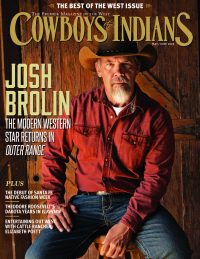By the time vaqueros became part of the Texas ranching landscape, they had already been herding and driving cattle and wild horses in Mexico for hundreds of years. And beginning on Sunday, August 23rd, the Phippen Museum will present Vaqueros & Hispanic Art, a special exhibition delving into the history of the vaquero and exploring the influence of Hispanic art on today’s modern American Southwest.
Cattle ranching had spread north into what is now Texas, Arizona and New Mexico by the 1700’s. The native cowboys were called vaqueros (from the Spanish word for cow) and developed roping skills, using braided rawhide reatas (the root word for lariat). But as more Americans flooded into once Mexican-held lands, ranching ceased to be a strictly Hispanic profession. The Anglo newcomers adapted the vaquero style, and many settlers intermarried with the old Spanish ranching families.
In fact, even trail-driving Texans adopted many of their techniques from Mexican vaqueros, carrying their methods with them north through the Plains states and leading to a subculture of single, itinerant men who worked on ranches.
And as long as cattle are raised in big American pastures, the legacy of the vaquero will endure. The early Mexican techniques for handling cattle can be seen throughout the modern livestock industry: cowboys cinching saddles on their horses, strapping on chaps (from chaparreras, Spanish for ‘leather leggings’), competing in rodeos (from rodear, Spanish for ‘to surround’), or roping horses from their remuda (from remudar, Spanish for ‘exchange’). In fact, even branding migrated north from Mexico.
So please be sure to take advantage of this great opportunity to make a visual journey into the life, times and herding traditions of the Vaquero and view some outstanding Hispanic art. This enlightening exhibit is on display at the museum through February 7th, 2016, in the Harold & Mitzie James Gallery.
The Phippen Museum is only a few minutes north of downtown Prescott at 4701 Highway 89 North. Admission is $7 for adults, $6 for AAA members, $5 for students with ID, and free for museum members and children twelve and under.






